These TS 8th Class Physical Science Important Questions 2nd Lesson Friction will help the students to improve their time and approach.
TS 8th Class Physical Science Important Questions 2nd Lesson Friction
Question 1.
What happens when the experiment Is repeated by using the rock and iron blocks of the same mass and different masses?
Answer:
If we replace wooden block with rock and iron blocks of same mass the limiting weight of the blocks changes with the roughness of the blocks. If different masses of rock and iron are used then the normal force applied by them will vary. In the same manner, there will be change in the speed of trolley and limiting weight.
Question 2.
Does the limiting weight change? If so why?
Answer:
Yes, the limiting weight changes. Because the roughness of the surfaces of stone, iron, and wooden blocks are not same.
Question 3.
Put some grease to the bottom of the wooden block and keep it on the trolley’s surface. What happens to the limiting weight?
Answer:
The limiting weight of the wooden block will decrease if we apply some grease to the bottom of the wooden block. Because grease will decrease the frictional force between the touching planes.
Question 4.
What should we have to do to Increase the limiting weight?
Answer:
To increase the limiting weight we have to increase the frictional force between trolley and wooden block. For this we have to increase the roughness of the surfaces, By increasing weights on the wooden box we can increase normal force with this we can increase frictional force as well as limiting weight.
![]()
Question 5.
Play carrom board without powder and next sprinkle fine powder on board. In which case the movement of the striker and the coins is easy? Why?
Answer:
The movement 01 the striker is easy when we sprinkle fine powder on the hoard. Powder decreases the frictional force between carroms and board and increases smoothness of the board.
Question 6.
Why do we pour few drops of oil on the hinges of a door?
Answer:
If we pour few drops of oil on the hinges of a door the will move freely. So we can decrease the friction between the hinges.
Question 7.
Why do we use grease between the moving parts of motor vehicle?
Answer:
If we apply grease between the moving parts of motor vehicle then it forms a thin layer which decreases the frictional force.
Question 8.
‘Objects move through fluids are given special shapes’ why?
Answer:
When objects move through fluids, fluid friction acted on them. In order to overcome the frictional force acting on them, objects are given special shapes. Idea of such shapes corne from the body structure of birds and fishes which have to move about in fluids all the time. Such shapes are called streamlined.
Question 9.
On what factors does the fluid friction depend?
Answer:
The friction on an object in a fluid depends on
- Speed of the object with respect to the fluid.
- The shape of the object.
- Nature of the fluid.
Question 10.
Name the two factors on which the magnitude of the frictional force depends.
Answer:
- Friction depends on the nature of (smooth or rough) surfaces which are in contact.
- Friction depends on how hard the two surfaces press together.
Question 11.
Ramya said some times we deliberately increase the friction. Give some examples.
Answer:
We deliberately increase the friction.
- Using brake pads in the brake system of bicycles and automobiles.
- Kabaddi players rub their hands with the soil for an easy grab of their opponents.
- Gymnasts apply some coarse substance on their hands to increase friction for better grip.
- Soles of shoes and tyres of vehicles are grooved to increase friction to better grip on the floor and road.
Question 12.
Explain why It Is convenient to pull the luggages fitted with rollers.
Answer:
Rolling reduces the friction. It is always easier to roll a body than to slide it over a surface. So it is convenient to pull the luggage fitted with rollers.
Friction ∝ Normal force
Question 13.
List the five smooth surfaces and five rough surfaces from your surroundings.
Answer:
Examples for smooth surfaces :
- Surface of an oily pot
- Marble floor of the room
- Glazed tiles
- Surface of the mirror
- Surface of wet soaps.
Rough Surfaces:
- Soles of shoes
- Surface of a brick
- Surface of tyres of vehicles
- Surface of playground
- Unpainted wall.
Question 14.
Prepare a toy to play with, which Is related to friction.
Answer:
A toy to play with:
Take an empty matchbox. Take out its tray. Cut a used refill of a ball pen of the same width as the tray as shown in the figure below. Fix the refill with two pins on the top of the tray as shown in fig. Make two holes on the opposite sides of the tray. Make sure that the holes are large enough to allow a thread to pass through them easily.
Take a thread about a metre long and pass it through the holes as shown. Fix beads at the two ends of the thread so that it does not come out. Insert the tray in the outer cover of the matchbox.
![]()
Suspend the matchbox by the thread. Leave the thread loose. The matchbox will start falling down due to gravity. Tighten the thread now and observe that matchbox will stop falling down.
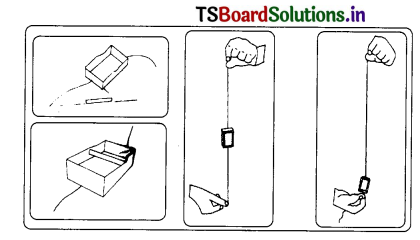
Question 15.
Rani is pushing a heavy trunk on the floor. Finding it a little difficult she turns the trunk to place it vertically. Will she need to less effort now? Explain.
Answer:
Friction is independent of area of contact. So even though she turns the trunk and place it vertically, she will need the same effort.
Question 16.
What is easier to move a box from rest, or to move It when it is already in motion?
Answer:
When the box starts sliding, the contact points on its surface, do not get enough time to lock into the contact points on the floor. So the sliding friction is slightly less than the static friction and you find It easier to move the box which is in motion than to get it started.
Question 17.
Draw a free-body diagram to show various forces acting on a body? When it is pushed on the floor?
Answer:
Two forces act on the body in the vertical direction. They are
- Weight of the body (W) or gravitational force acting vertically down.
- Normal force (N) or reaction force applied by the floor vertically upward. Two forces act on the body in horizontal direction. They are
- Force applied on it (F)
- Frictional force (f), which is opposite to F.
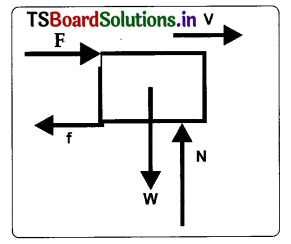
Question 18.
What conditions are needed for static friction to come into play?
Answer:
Static friction comes to play when surfaces of the objects are at rest relative to each other.
Static friction is a self-adjusting force, until the applied force is more than the limit of the static friction. The applied bodies are at rest relative to each other.
Question 19.
Give examples of practical applications of static friction.
Answer:
- Brick on a table does not move because static friction is there in between table and brick.
- Vehicles are stable on roads because static friction acts between road and tyres of vehicles.
- We are able to stand on the floor due to the static friction.
- We are able to hold objects with our hands because of static friction.
Question 20.
How can you measure frictional force?
Answer:
Frictional force (F) is proportional to the normal force (N). F ∝ N. Tie a string around a brick, pull the brick by using a spring balance. The change in the length of the spring is proportional to the applied force. So the scale of the spring balance gives directly the applied force in Newtons.
Pull the spring balance to make a move in the brick. Note down the reading of spring balance when the brick just begins to move. In this way we can measure frictional force.
![]()
Question 21.
How Is the friction responsible for energy wastages? Give suggestions to reduce energy wastage by the friction.
Answer:
- Friction acts all the time. It reduces the speed of the body in motion.
- Additional force has to be applied from time to time to maintain motion and the speed.
- For this more fuel is consumed. This adds to the cost of running.
- In this way friction is responsible for energy wastage.
- To reduce energy wastage by friction and to save fuel we adopt ways and means to reduce friction, such are lubricants, greases, ball bearings, streamlined.
Question 22.
What ways do you know to reduce friction?
Answer:
Friction is both a friend and an evil, We have to minimise friction in some cases. There are several methods to reduce friction. They are:
- By using lubricants such as oil, wax or grease.
- By using rollers or ball bearings between the surfaces which touch each other.
- By smoothing the surfaces which are in contact.
- By using talcum powder or air cushions.
- By using an aerodynamic shape.
Question 23.
Seetha is observing a moving bus with the luggage on its top. As the bus is moving slowly there is change in the state of luggage on Its top. But when the bus speeds up and starts moving fast, she noticed that the luggage on the top of the bus fell to the back of the bus. This raised many doubts in her mind regarding to the effect of frictional force
acting on the luggage as well as on the tires of the bus. Can you guess the questions raised in her mind? Write them.
Answer:
I think the following questions are raised in Scethas mind.
- Why there is a change in the state of luggage when the bus is moving slowly?
- Why the luggage on the top of the bus fell back to the bus, when it gets speed and starts moving fast?
- What is the effect of frictional force acting on the luggage?
- What is the effect of frictional force on the tyres of the bus?
diagram:
1.
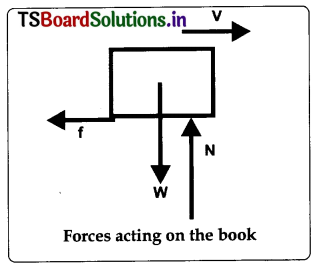
2.
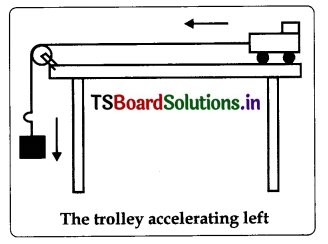
3.
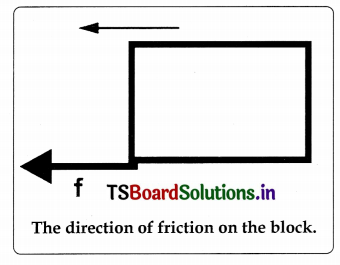
4.

5.
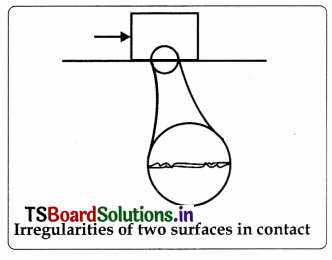
6.

7.

8.

9.
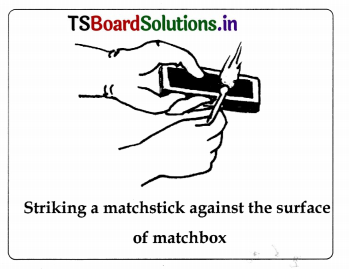
10.
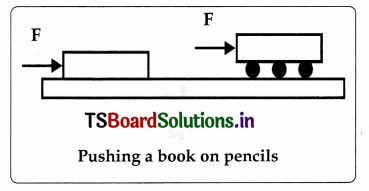
Choose the correct answers:
Question 1.
The substances which reduce friction are called ( )
A) lubricant
B) drag
C) friction
D) streamlined
Answer:
A) lubricant
Question 2.
Friction due to fluid is called ( )
A) friction
B) force
C) drag
D) pressure
Answer:
C) drag
Question 3.
Which is an example of rough surface …….. ( )
A) surface of mirror
B) surface of wet soap
C) glazed tiles
D) surface of a brick
Answer:
A) surface of mirror
Question 4.
Which is an example of smooth surface? ( )
A) soles of shoes
B) surface of brick
C) glazed tiles
D) surface of tyres
Answer:
C) glazed tiles
![]()
Question 5.
Friction can be reduced by using ( )
A) oil
B) grease
C) powder
D) all of these
Answer:
D) all of these
Question 6.
………………. is the responsible for wearing out of cycle lyres. ( )
A) magnetic force
B) frictional force
C) muscular force
D) gravitational force
Answer:
B) frictional force
Question 7.
Friction depends on the ………………… . ( )
A) nature of surface
B) volume
C) area
D) nature of material
Answer:
A) nature of surface
Question 8.
‘which of the following is minimum? ( )
A) static friction
B) sliding friction
C) rolling friction
D) none
Answer:
A) static friction
Question 9.
Friction can be increased by ………………. . ( )
A) powder
B) rough surface
C) smooth surface
D) oil
Answer:
B) rough surface
Question 10.
Ball bearings are used to convert static friction into ( )
A) drag
B) sliding friction
C) rolling friction
D) all the above
Answer:
C) rolling friction
Question 11.
Friction produces ………………. . ( )
A) heat
B) cool
C) pressure
D) mechanical energy
Answer:
A) heat
Question 12.
Fluid friction depends on …………….. . ( )
A) speed of the object
B) shape of the object
C) nature of the fluid
D) all the above
Answer:
D) all the above
![]()
Question 13.
Friction is independent of ………… ( )
A) roughness
B) area of contact
C) weight of the object
D) all the above
Answer:
B) area of contact
Question 14.
Maximum value of static friction is called ……………… . ( )
A) limiting friction
B) sliding friction
C) rolling friction
D) all the above
Answer:
A) limiting friction
Question 15.
It is easy to ………………. the body. ( )
A) push
B) pull
C) A and B
D) none
Answer:
C) A and B
IIT Foundation material
Question 1.
An aeroplane flies through the air at constant velocity. We say it is in equilibrium. Two horizontal forces act on the plane. One horizontal force is the thrust of the propeller that pushes it forward. The other is the force of air resistance that acts in the opposite direction of these two, which of these two forces is greater?
Answer:
Both forces have the same magnitude.
Question 2.
When a space shuttle travels in a nearly circular orbit around the earth, is a force required to maintain its high speed? What type of path would the shuttle follow if suddenly the force of gravity were cut off?
Answer:
No force in the direction of the motion of the shuttle exists. The shuttle coasts at a constant speed by its own inertia. The only force acting on the shuttle is the force of gravity. It acts at right angles to its motion (towards the earth’s centre). Well, see Liter that this right-angled force holds the shuttle in a circular path. The shuttle would move in a straight line at a constant speed (constant velocity) if it were cut off.
Question 3.
a) What will be the direction of the frictional force acting on a ball which is rolling on a road towards the north?
b) if the direction of movement in the above case is changed to the south by applying force, then what will be the direction of the frictional force?
Answer:
a) South
b) North.
Question 4.
Raju is pushing a heavy trunk on the floor. Finding it a little difficult, lie turns the trunk to place it vertically. Will he need to do less effort now? Explain.
Answer:
No, Raju will need the same effort because even hr placing it vertically same amount of friction will be there. Friction does not depend upon the area of contact.